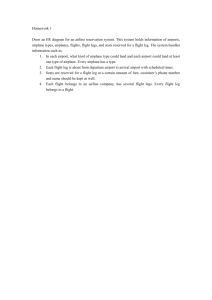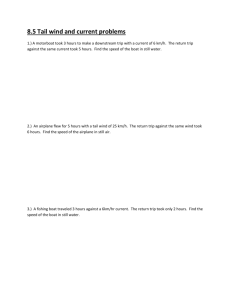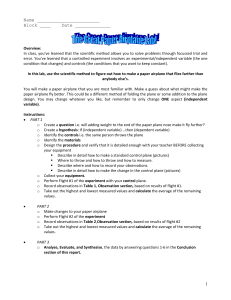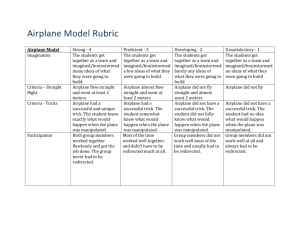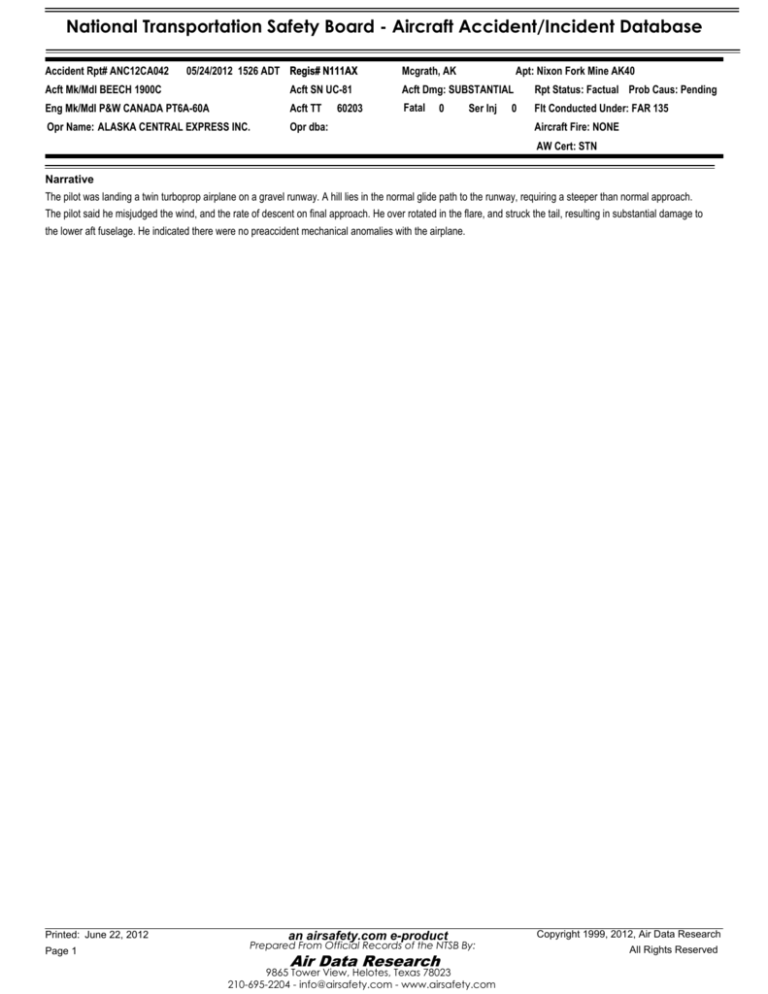
National Transportation Safety Board - Aircraft Accident/Incident Database
Accident Rpt# ANC12CA042
05/24/2012 1526 ADT Regis# N111AX
Apt: Nixon Fork Mine AK40
Mcgrath, AK
Acft Mk/Mdl BEECH 1900C
Acft SN UC-81
Acft Dmg: SUBSTANTIAL
Rpt Status: Factual Prob Caus: Pending
Eng Mk/Mdl P&W CANADA PT6A-60A
Acft TT
Fatal
Flt Conducted Under: FAR 135
Opr Name: ALASKA CENTRAL EXPRESS INC.
Opr dba:
60203
0
Ser Inj
0
Aircraft Fire: NONE
AW Cert: STN
Narrative
The pilot was landing a twin turboprop airplane on a gravel runway. A hill lies in the normal glide path to the runway, requiring a steeper than normal approach.
The pilot said he misjudged the wind, and the rate of descent on final approach. He over rotated in the flare, and struck the tail, resulting in substantial damage to
the lower aft fuselage. He indicated there were no preaccident mechanical anomalies with the airplane.
Printed: June 22, 2012
Page 1
an airsafety.com e-product
Prepared From Official Records of the NTSB By:
Air Data Research
9865 Tower View, Helotes, Texas 78023
210-695-2204 - info@airsafety.com - www.airsafety.com
Copyright 1999, 2012, Air Data Research
All Rights Reserved
National Transportation Safety Board - Aircraft Accident/Incident Database
Accident Rpt# ERA12LA379
06/04/2012 955 EDT
Regis# N427AL
Indiantown, FL
Acft Mk/Mdl BELL 427
Acft SN 56018
Acft Dmg: SUBSTANTIAL
Rpt Status: Prelim
Eng Mk/Mdl PRATT & WHITNEY PW207D
Acft TT
Fatal
Flt Conducted Under: FAR 091
Opr Name:
Opr dba:
1345
0
Ser Inj
0
Prob Caus: Pending
Aircraft Fire: NONE
AW Cert: STN
Narrative
On June 4, 2012, about 0955, eastern daylight time, a Bell 427 helicopter, N427AL, registered to Southern Aviation Systems, LLC., and operated by an individual,
experience an inflight bird strike, main rotor vibration, and a hard landing near Indiantown, Florida. The private-rated pilot, commercial-rated co-pilot, and 3
passengers received minor injuries. The helicopter sustained substantial damage. Visual meteorological conditions prevailed and no flight plan was filed for the
Title 14 Code of Federal Regulations Part 91, business flight. The flight originated from the Palm Beach International Airport (PBI), West Palm Beach, Florida,
about 0930.
The pilot stated they departed PBI for a destination of Ocala, Florida. Approximately 25 minutes into the flight, while on a heading of 330-degrees and at an
altitude of 800 feet mean sea level (msl), he maneuvered the helicopter to avoid colliding with several large birds. The pilot felt something impact the upper right
side of the helicopter near the main rotor mast area. Immediately following the impact, the helicopter started shaking violently, and became difficult to control. The
pilot elected to land in an open field. Descending through 300 feet msl, the shaking became more pronounce and the helicopter became uncontrollable. About 50
feet msl, the aircraft went into a spin and impacted the ground hard and rolled over on its left side. All onboard were able to exit the helicopter on their own.
Postaccident inspection of the helicopter by a Federal Aviation Administration Inspector and a representative of the aircraft manufacturer revealed evidence of
bird remains on components of the rotor head and on 2 of the 4 pitch change rods. The 2 pitch change rods with bird remains were separated from one of their
attach points. The bird remains were removed and are being sent to the Smithsonian for bird identification.
Printed: June 22, 2012
Page 2
an airsafety.com e-product
Prepared From Official Records of the NTSB By:
Air Data Research
9865 Tower View, Helotes, Texas 78023
210-695-2204 - info@airsafety.com - www.airsafety.com
Copyright 1999, 2012, Air Data Research
All Rights Reserved
National Transportation Safety Board - Aircraft Accident/Incident Database
Accident Rpt# DCA12RA065
04/20/2012 1340 UTC Regis# APBKC
Acft Mk/Mdl BOEING 737-200
Acft SN 23167
Acft Dmg: DESTROYED
Fatal 127
Opr Name: BHOJA AIR
Apt: Islamabad Benazir Bhutto Int'l ISB
Islamabad, PK
Ser Inj
Opr dba:
Rpt Status: Prelim
0
Prob Caus: Pending
Flt Conducted Under: FAR NUSC
Aircraft Fire: GRD
AW Cert: STT
Narrative
On April 20, 2012, at about 1840 local time, Bhoja Air flight BH0213, a Boeing 737-236, registration AP-BKC, crashed about 3.7 miles short of runway 30 during
an approach to landing at the Benazir Bhutto International Airport, Islamabad, Pakistan. The flight originated from Jinnah International Airport, Karachi, Pakistan.
All 127 people on board were fatally injured, and the aircraft was destroyed. Heavy rain and thunderstorms were reported at the time of the accident.
The Government of Pakistan is investigating the accident and has appointed an Investigator-in-Charge (IIC) along with investigators from the Pakistan Civil
Aviation Authority (CAA) and the Pakistan Air Force. As the state of design and manufacture of the airplane and engines, the NTSB has designated a U.S.
accredited representative to assist the Pakistan Government in their investigation under the provisions of Annex 13 to the Convention on International Civil
Aviation.
All inquiries should be directed to:
Headquarters, Civil Aviation Authority
Terminal-1, JIAP
Karachi-75200
Pakistan
E-mail: psib@caapakistan.com.pk
Printed: June 22, 2012
Page 3
an airsafety.com e-product
Prepared From Official Records of the NTSB By:
Air Data Research
9865 Tower View, Helotes, Texas 78023
210-695-2204 - info@airsafety.com - www.airsafety.com
Copyright 1999, 2012, Air Data Research
All Rights Reserved
National Transportation Safety Board - Aircraft Accident/Incident Database
Incident Rpt# WPR10IA256
05/23/2010 1020 PDT Regis# N925SW
Apt: Ontario International Airport ONT
Ontario, CA
Acft Mk/Mdl BOMBARDIER INC CL-600-2B19
Acft SN 7682
Acft Dmg: MINOR
Eng Mk/Mdl GE CF34 SERIES
Acft TT
Fatal
Opr Name: SKYWEST AIRLINES INC
Opr dba:
20292
0
Ser Inj
Rpt Status: Factual Prob Caus: Pending
0
Flt Conducted Under: FAR 121
Aircraft Fire: NONE
Narrative
On May 23, 2010, about 1020 Pacific daylight time (PDT), Skywest Airlines flight 6467, a Bombardier CRJ, CL-600-2B19, N925SW, made an emergency landing
with the nose gear in the retracted position at Ontario International Airport (ONT), Ontario, California. Skywest Airlines, Inc., was operating the airplane as a
scheduled domestic passenger flight under the provisions of 14 Code of Federal Regulations (CFR) Part 121. The certificated airline transport pilot captain,
commercial pilot first officer, flight attendant, and 24 passengers were not injured. The flight departed San Francisco International Airport (SFO), San Francisco,
California, about 0815 as a non-stop to Ontario. Visual meteorological (VMC) conditions prevailed, and an instrument flight rules (IFR) flight plan had been filed.
The crew reported that the flight was uneventful until they were on final approach for landing at ONT. The landing gear selector was moved to the down position.
The main landing gear extended and locked into place; however, the nose landing gear remained retracted. The crew observed an unsafe nose landing gear
indication.
The crew aborted the landing approach, and advised air traffic control (ATC) of the emergency. The crew attempted to correct the landing gear malfunction by
following the emergency procedures utilizing the Quick Reference Handbook (QRH), but was unsuccessful. The crew conducted a low-level flyby to have tower
and ground personnel evaluate the condition of the nose landing gear. The landing gear doors were open, but the nose landing gear was still retracted in the
landing gear compartment.
Due to the unsuccessful attempt to lower the nose landing gear, the crew decided to make an emergency landing. After the main landing gear touched down, the
captain held the nose off the ground as long as possible. The nose landing gear doors touched down on the runway centerline, and the airplane slid about 2,000
feet. The passengers and crew exited the airplane using the main cabin door.
The airplane's Cockpit Voice Recorder (CVR), and the Flight Data Recorder (FDR) were removed and shipped to the NTSB CVR/FDR lab in Washington, DC, for
download and read out. A factual report for the CVR and the FDR are attached to the docket.
After the airplane was jacked up using airbags and the nose gear extended, an examination of the damage to the belly of the airplane was determined to be
minor.
The airplane was towed to a fixed base operator-(FBO) to prepare the airplane for a ferry flight to one of the operator's maintenance facilities.
On May 26, 2010, the airplane was flown from ONT to Fresno, California, on a ferry permit.
On May 27 and 28, 2010, investigators examined the airplane's landing gear systems. The nose landing gear was removed from the airframe and shipped to the
manufacturer for further examination. A copy of the inspection with the observations and findings are attached to the docket.
Investigators convened at the Messier-Dowty, the manufacturer of the nose landing gear on August 1, 2010. An examination of the landing gear was
accomplished and a copy of the report is attached to the docket.
Hydraulic samples were taken from the (3) nose gear landing servos and submitted for analysis. All results appeared normal, except for the sample from the
Uplock Actuator servo, which revealed "PARTICLES APPEAR ABNORMAL AT NAS CLASS 12, NAS CLASS 9 OR BETTER IS RECOMMENDED" All other
tests appear normal.
After all examinations, the investigation found no abnormalities that would have precluded normal operations of the landing gear system.
Printed: June 22, 2012
Page 4
an airsafety.com e-product
Prepared From Official Records of the NTSB By:
Air Data Research
9865 Tower View, Helotes, Texas 78023
210-695-2204 - info@airsafety.com - www.airsafety.com
Copyright 1999, 2012, Air Data Research
All Rights Reserved
National Transportation Safety Board - Aircraft Accident/Incident Database
Accident Rpt# CEN12CA319
05/25/2012 1735 CDT Regis# N11ZX
Apt: Fairmont Municipal FRM
Delavan, MN
Acft Mk/Mdl HUGHES 369HS
Acft SN 640609S
Acft Dmg: SUBSTANTIAL
Rpt Status: Factual Prob Caus: Pending
Eng Mk/Mdl ALLISON 250-C20
Acft TT
Fatal
Flt Conducted Under: FAR 137
Opr Name: TERYJON AVIATION, INC.
Opr dba:
8836
0
Ser Inj
1
Aircraft Fire: NONE
AW Cert: STN
Narrative
The pilot reported that he was spraying a drainage ditch when he encountered a railroad track embankment. He increased altitude to clear the tracks, but as he
descended back into the ditch on the opposite side of the tracks to continue spraying, he observed a set of power lines in his flight path. He attempted to
maneuver to avoid the lines, but the left landing skid of the helicopter struck the lines. The helicopter subsequently impacted an adjacent corn field about 250 feet
from the power lines. The pilot was seriously injured, and the helicopter sustained substantial damage to the fuselage and tailboom. The pilot reported that there
were no failures or malfunctions related to the helicopter prior to the accident.
Printed: June 22, 2012
Page 5
an airsafety.com e-product
Prepared From Official Records of the NTSB By:
Air Data Research
9865 Tower View, Helotes, Texas 78023
210-695-2204 - info@airsafety.com - www.airsafety.com
Copyright 1999, 2012, Air Data Research
All Rights Reserved
National Transportation Safety Board - Aircraft Accident/Incident Database
Accident Rpt# ERA12FA385
06/07/2012 1235 EDT Regis# N950KA
Lake Wales, FL
Acft Mk/Mdl PILATUS AIRCRAFT LTD PC-12/47
Acft SN 730
Acft Dmg: SUBSTANTIAL
Rpt Status: Prelim
Eng Mk/Mdl P&W CANADA PT6A-67B
Acft TT
Fatal
Flt Conducted Under: FAR 091
Opr Name: ROADSIDE VENTURES, L.L.C.
Opr dba:
1263
6
Ser Inj
0
Prob Caus: Pending
Aircraft Fire: GRD
AW Cert: STN
Narrative
On June 7, 2012, about 1235 eastern daylight time, a Pilatus PC-12/47, N950KA,registered to and operated by Roadside Ventures, LLC, departed controlled
flight followed by subsequent in-flight breakup near Lake Wales, Florida. Instrument meteorological conditions prevailed at the altitude and location of the
departure from controlled flight and an instrument flight rules (IFR) flight plan was filed for the 14 Code of Federal Regulations (CFR) Part 91 personal flight from
St. Lucie County International Airport (FPR), Fort Pierce, Florida, to Freeman Field
Airport (3JC), Junction City, Kansas. The airplane was substantially damaged and the certificated private pilot and five passengers were fatally injured. The flight
originated from FPR about 1205.
According to preliminary Federal Aviation Administration (FAA) air traffic control information, after departure, air traffic control communications were transferred to
Miami Air Route Traffic Control Center (Miami Center). While in contact with that facility, about 1229, the flight was cleared to flight level (FL) 250. At about 1230,
the controller cleared the flight to FL260, which the pilot acknowledged. At about 1232, the controller advised the pilot of a large area of precipitation northwest of
Lakeland, with moderate, heavy and extreme echoes. The controller asked the pilot to look at it and to advise what direction he needed to deviate, then
suggested deviation right of course until north of the adverse weather. The pilot responded that he agreed, and the controller asked the pilot what heading from
his position would keep the airplane clear, and the pilot responded 320 degrees. The controller cleared the pilot to fly heading 320 degrees, and to deviate right of
course when necessary, and when able proceed direct to Seminole, which he acknowledged. There was no further recorded communication from the pilot with
the Miami Center.
According to preliminary radar data, between 1232:37, and 12:33:25, the airplane proceeded in a west-northwesterly direction, and climbed from 24,700 to 25,100
feet, then maintained that altitude for the next 12 seconds; however, a change in direction to the right was noted. Between 1233:37, and 1233:49, the airplane
descended from 25,100 to 24,200 feet, and turned to the right, and between 1233:49, and 1234:01, the airplane descended from 24,200 to 22,500 feet, and
continued the right turn. Between 1234:01 and 1234:37, the airplane descended from 22,500 to 10,700 feet, and turned to a southerly heading. Between 1234:37,
and 1234:49, the airplane turned left and proceeded on a northeasterly heading. Between 1234:49, and 1235:37 (last secondary return at 1,300 feet), the airplane
continued on a northeasterly heading.
The pilot of a nearby airplane reported to FAA air traffic control and NTSB hearing a Mayday call about 1 minute before hearing the sound of an emergency
locator transmitter (ELT) signal.
A witness who was located about 1.5 nautical miles and 193 degrees from the crash site reported that on the date and time of the accident, he was inside his
house and first heard a sound he attributed to a propeller feathering or later described as flutter of a flight control surface. The sound lasted 3 to 4 cycles of a
whooshing high to low sound, followed by a sound he described as an energy release. He was clear the sound he heard was not an explosion, but more like
mechanical fracture of parts. He ran outside, and first saw the airplane below the clouds (ceiling was estimated to be 10,000 feet). He noted by silhouette that
parts of the airplane were missing, but he did not see any parts separate from the airplane during the time he saw it. At that time it was not raining at his location.
He went inside his house, and got a digital camera, then ran back outside to his pool deck, and videotaped the descent. He reported the airplane was in a spin
but could not recall the direction. The engine sound was consistent the whole time; there was no revving; he reported there was no forward movement. He called
911 and reported the accident.
Another witness who was located about .4 nautical mile and 125 degrees from the crash site reported hearing a boom sound that he attributed to a lawn mower
which he thought odd because it had just been raining. He saw black smoke trailing the airplane which was spinning. He ran to the side of their house, and noted
the airplane was still spinning. His brother came by their back door, they heard a thud, and both ran direct to the location of where they thought the airplane had
crashed. When they arrived at the wreckage, they saw fire in front of the airplane which one individual attempted to extinguish by throwing sand on it, but he was
unable. The other individual reported the left forward door was hard to open, but he pushed it up and then was able to open it. Both attempted to render
assistance; one individual called 911 to report the accident and then guided local first responders to the accident site.
Preliminary examination of the accident site revealed the wreckage consisting of the fuselage and sections of both wings came to rest upright in an open field.
Printed: June 22, 2012
Page 6
an airsafety.com e-product
Prepared From Official Records of the NTSB By:
Air Data Research
9865 Tower View, Helotes, Texas 78023
210-695-2204 - info@airsafety.com - www.airsafety.com
Copyright 1999, 2012, Air Data Research
All Rights Reserved
National Transportation Safety Board - Aircraft Accident/Incident Database
Sections of both wings, and also the horizontal stabilizer and elevator were separated. The separated components consisting of sections of both wings, the
horizontal stabilizer, and elevator were located, tagged as to their location, and secured with the main wreckage.
The pilot, age 45, held a private pilot certificate with airplane single engine land, and instrument airplane ratings.
Printed: June 22, 2012
Page 7
an airsafety.com e-product
Prepared From Official Records of the NTSB By:
Air Data Research
9865 Tower View, Helotes, Texas 78023
210-695-2204 - info@airsafety.com - www.airsafety.com
Copyright 1999, 2012, Air Data Research
All Rights Reserved

